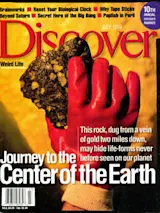James Fujimoto looks at the human body much the way an air-traffic controller monitors airplanes. He scans for signs of trouble and does it all without interfering with the action. Even his technique—called optical coherence tomography, or OCT—is somewhat similar. "OCT is analogous to radar or ultrasound," Fujimoto explains. "We're shining light on an object and measuring the amount of time it takes that light to return." Fujimoto has to work fast: the echoes he studies happen on a timescale measured in femtoseconds (10-15 seconds). To gather data in those fleeting moments, he has used fiber-optic technologies, tricks of the optical trade, and his own instincts. Fujimoto, modest by nature, is quick to point out that many other researchers also lent a hand.
The beauty of optical coherence tomography comes shining through in the images it produces. They have a resolution ten times that of ultrasound, fine enough to pick out individual cells in diseased tissue. And unlike other forms of optical microscopy, this one can watch biological processes without any invasive procedures. OCT is already producing superlative images of the retina. "The retina itself is only 300 microns in depth, so we can resolve its structure and see any pathological changes with higher resolution than in any other imaging modality," Fujimoto says.
Because light is strongly scattered by tissue, OCT can't penetrate more than about one-tenth of an inch, but that is still deep enough for most biopsies. A doctor might attach an OCT scanner to a catheter or a laparoscope and guide it to a suspicious lump; the device would then snap detailed images that could reveal whether cells were malignant or benign.
Humphrey Systems, a division of Carl Zeiss, is currently producing an OCT device, which it sells to ophthalmology clinics. Last year, Fujimoto's group and Zeiss teamed up to create Coherent Diagnostic Technology, a new company that will commercialize the technique for other types of medical diagnostics. "Innovation is really a process that unfolds over a period of time," Fujimoto says. "You need to know where the boundaries are so you can go beyond them." FINALISTS Illuminating the Body INNOVATORS: Watt W. Webb, Cornell Winfried Denk, Bell Laboratories
Shine a black light on one of those fluorescent posters of the 1970s, and it emits an eerie glow. Bombard our bodies with a properly tuned laser, and individual molecules will likewise light up. By focusing on these excitable molecules, researchers from Cornell are producing exquisite, luminous images of the tiniest goings-on, without any damage to the cells being studied.
Watt Webb, leader of the Cornell team, explains that "a molecule can simultaneously absorb two or more photons from a focused laser beam and become excited to an energy that corresponds to the sum of all the photons simultaneously absorbed." When the molecule releases that pent-up energy, the resulting fluorescent gleam is captured and displayed on a video screen.
Winfried Denk, who coinvented multiphoton microscopy at Cornell, is now at Bell Labs, where he is using the technique to study the role of dendrites—signal catchers located at the tail end of a neuron—in rats' brains.
Meanwhile, Webb's lab is producing the first-ever images of granules in brain cells releasing serotonin, a chemical that transmits neural signals. Webb and his colleagues are also exploring the possibility of using multiphoton microscopy to help physicians locate tumors during brain surgery (cancer cells give a distinctive glow) and track pharmaceuticals as they course through the body. Downsized Dissection INNOVATORS: Thomas M. Baer, Arcturus Engineering; Robert Bonner, National Institutes of Health
Tracking the progress of disease within the body can be like hunting for a face in a crowd. Tissues that contain important diagnostic clues include a bewildering mix of cells—healthy cells, mildly affected ones, and ones in advanced stages of disease. "We knew we could get exciting molecular analyses if we could only isolate specific cells from all the cells surrounding them," says Robert Bonner.
His team at NIH discovered how to pluck out individual cells, by getting them a little sticky. They used an ultrafine laser beam to melt an adhesive film onto desired cells—and only those cells—within a tissue sample. Whatever cells the laser hit adhered to the transfer film, allowing them to be lifted off and analyzed. Arcturus Engineering, headed by Thomas Baer, took Bonner's concept and turned it into the PixCell Laser Capture Microdissection Device. After just a few months of research and development, Arcturus had the PixCell ready for sale. Today it is in more than 150 medical research institutes worldwide, where it is aiding in the diagnosis of various types of cancer, multiple sclerosis, Alzheimer's disease, hepatitis, and arteriosclerosis.














